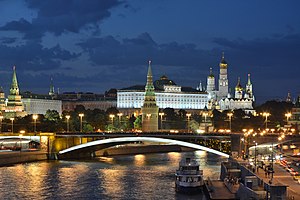Bolshoy Kamenny Bridge

55°44′48″N 37°36′44″E / 55.74667°N 37.61222°E Bolshoy Kamenny Bridge (
Bolshoy Kamenny Bridge (1692, demolished)

A "live" bridge of boats linked the Kremlin with
Sources about the completion of the first Stone Bridge are contradictory.
- The most widely accepted version attributes it to Patriarch Filaret, who picked up the job in 1682; year of completion is either 1687 or 1692.
- Another version connects the completion in 1687 with Vasily Golitsyn, notable for his sponsorship of architecture.
Archive studies by
It is estimated that the river maximum width was 105 meters (50
The bridge deck originally included wooden storehouses, mills, taverns and tax collector's booths. All of these additions were destroyed in 1785 by the governor's decree. Still, it remained a busy public square and a place for religious ceremonies. Police reported frequent illegal
Bolshoy Kamenny Bridge (1859, demolished)


The Second Stone Bridge was built in 1859 by colonel Tannenberg on the same site, in line with today's Lenivka Street. The new bridge had three steel arched spans (36+40+36 meters) on stone pillars, similar to still existing Novospassky Bridge and Borodinsky Bridge. The main drawback, compared to these later bridges, was that the Stone Bridge left no free passage for the traffic on embankments. Riverside traffic had to cross bridge traffic in the same level. This design error became a problem even before automobiles and this is why the Second Stone bridge was demolished in 1930s, while Novospassky Bridge still stands.[4]
Bolshoy Kamenny Bridge (1938)
The first contest for the Third Stone Bridge was held in 1921; none of the entries were selected. The second contest was won jointly by engineer Nikolai Kalmykov and Schuko-Gelfreikh-Minkus team of architects.
Kalmykov's design was completed in 1935-1938, on a site which is two blocks closer to Kremlin than the previous bridges. The single arched span is 105 meters wide and 8.4 meter high. A total of 6 parallel, boxed steel arches support the 40 meter wide roadway. The arch rests on submerged caisson foundations. Embankment traffic uses two 42.5 meter long side arches. Total length, including approach ramps, is 487 meters. There are 8 lanes for regular traffic and a divider lane.[4]
See also
References
- ^ Manaev, G. (2019-12-18). "10 LOST architectural wonders of Moscow (PHOTOS)". Russia Beyond the Headlines. Retrieved 2020-01-29.
- ^ Russian: Энциклопедия "Москва", M, 1997 (Encyclopedia of Moscow, Moscow, 1997)
- ^ Russian: Иван Кондратьев. "Седая старина Москвы", М, 1997, first edition 1893, online at uutdoors.ru Archived 2007-09-27 at the Wayback Machine
- ^ ISBN 5-9533-0183-9
